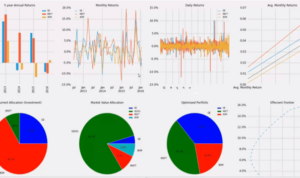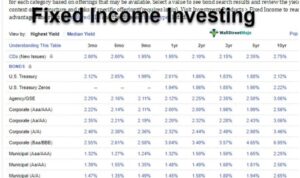Diving into the world of Investment risks and rewards, this intro sets the stage for an exciting journey filled with twists and turns. Get ready to uncover the secrets behind making smart investment decisions and reaping the benefits of your choices.
In this exploration, we’ll navigate through the different types of risks, factors that influence them, strategies to minimize risks, and the intriguing relationship between risks and potential rewards.
Types of Investment Risks
When it comes to investing, there are several types of risks that investors need to consider. Understanding these risks is crucial in making informed decisions and managing investment portfolios effectively.
Market Risk
Market risk, also known as systematic risk, refers to the possibility of investments losing value due to factors affecting the overall market. This type of risk is beyond the control of individual investors and can impact all investments within a particular market. For example, economic downturns, political instability, and natural disasters can all contribute to market risk.
Credit Risk
Credit risk is the risk of an investment losing value due to the issuer’s inability to repay the principal or interest on a debt security. This risk is commonly associated with bonds and other fixed-income investments. For instance, if a company defaults on its bond payments, investors may face losses due to credit risk.
Inflation Risk
Inflation risk refers to the possibility of investments not keeping pace with inflation, leading to a decrease in purchasing power over time. This risk is particularly relevant for fixed-income investments such as bonds and savings accounts. If the rate of return on an investment is lower than the rate of inflation, investors may experience a decline in real value.
Liquidity Risk
Liquidity risk is the risk of not being able to sell an investment quickly at a fair price. Illiquid investments, such as certain real estate properties or private equity holdings, can be challenging to sell in a timely manner. Investors may face liquidity risk when they need to access funds urgently but cannot find a buyer for their illiquid assets.
Currency Risk
Currency risk, also known as exchange rate risk, refers to the potential impact of fluctuations in foreign exchange rates on investment returns. This risk is relevant for investors holding assets denominated in a currency different from their own. For example, if the value of the foreign currency depreciates against the investor’s home currency, it can lead to losses when the investment is converted back.
Factors Influencing Investment Risks
When it comes to investing, there are various factors that can influence the level of risk associated with an investment. These factors can range from market conditions to specific company performance, and understanding them is crucial for making informed investment decisions.
Market Volatility
Market volatility refers to the degree of variation in trading prices over time. High volatility can lead to greater investment risks as prices can fluctuate significantly in a short period. Factors such as geopolitical events, economic indicators, and investor sentiment can all contribute to market volatility.
Company Performance
The performance of a company can also impact investment risks. Factors such as revenue growth, profitability, debt levels, and management effectiveness can all influence the risk associated with investing in a particular company. A company with strong financials and a solid business model may present lower risks compared to a company facing financial difficulties.
Regulatory Changes
Changes in regulations can introduce new risks for investors. For example, regulatory changes in a specific industry can impact companies operating within that sector, leading to uncertainties and potential risks for investors. Keeping abreast of regulatory developments is essential for managing investment risks effectively.
Economic Conditions
Economic conditions play a significant role in influencing investment risks. Factors such as inflation, interest rates, and overall economic growth can impact investment returns. During times of economic downturn, investments may face higher risks due to reduced consumer spending, market instability, and other economic challenges.
Global Events
Global events, such as natural disasters, political unrest, or pandemics, can also affect investment risks. These events can create uncertainties in the market, leading to increased volatility and potential losses for investors. Being aware of global events and their potential impact on investments is crucial for managing risks effectively.
Strategies to Mitigate Investment Risks
When it comes to investing, it’s crucial to have a solid risk management strategy in place to minimize potential losses and maximize returns. By understanding how to mitigate investment risks effectively, investors can protect their portfolios and achieve their financial goals.
Diversification to Mitigate Risks
Diversification is a key strategy used to mitigate investment risks by spreading out investments across different asset classes, industries, and geographical regions. By not putting all your eggs in one basket, diversification helps reduce the impact of any single investment underperforming or facing a downturn. For example, instead of investing all your money in one stock, you can spread it out among stocks, bonds, real estate, and other types of assets to balance risk and potential rewards.
Asset Allocation for Risk Reduction
Asset allocation is another essential strategy to reduce investment risks by determining the right mix of assets in a portfolio based on an investor’s risk tolerance, time horizon, and financial goals. By diversifying investments across various asset classes like stocks, bonds, cash, and real estate, investors can minimize the impact of market fluctuations on their overall portfolio. For instance, a conservative investor may allocate a larger portion of their portfolio to bonds and cash for stability, while an aggressive investor may have a higher allocation to stocks for potential growth.
Relationship Between Investment Risks and Rewards

When it comes to investing, the relationship between risk and potential rewards is crucial to understand. Generally, the higher the risk of an investment, the higher the potential returns, but this also means a higher chance of losing money. On the other hand, lower risk investments typically offer lower returns but come with more stability and security.
Evaluating Risk-Return Trade-offs
Investors carefully assess the risk-return trade-offs when making investment decisions to strike a balance between maximizing returns and managing risks. This involves considering their risk tolerance, investment goals, and time horizon.
Examples of High-Risk Investments
High-risk investments such as investing in emerging markets, cryptocurrencies, or individual stocks can potentially yield significant rewards. However, they also come with a higher likelihood of experiencing losses due to market volatility and other factors.






